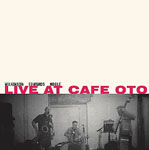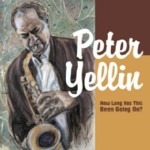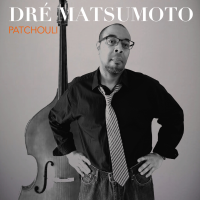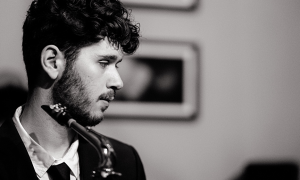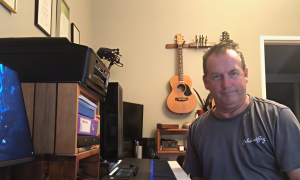Home » Jazz Articles » Take Five With... » Take Five With Marc Sabatella
Take Five With Marc Sabatella
 Meet Marc Sabatella:
Meet Marc Sabatella:Marc Sabatella is a jazz pianist based in Denver, Colorado. Whether playing with his award-winning band, in solo performance, or in partnership with other musicians, Marc emphasizes textural variety, energetic yet intelligent improvisation, and a creative sense of groove. The result is an intensely personal music that has proven to have unusually broad appeal. Marc has developed a strong reputation both within the jazz community and among musicians and audiences that would not otherwise claim an interest in jazz.
Instrument(s):
Piano.
Teachers and/or influences?
My first teacher was Elizabeth Scheidel, and it was from her I learned to love making music. Teachers that have shaped my jazz playing and writing include Susan Muscarella, Art Lande, Eric Gunnison, and Dave Hanson.
Of course, I have also learned just by listening; in that sense my greatest piano teachers have included Oscar Peterson, Bill Evans, Thelonious Monk, Herbie Hancock, Don Pullen. And I have also learned a lot about music from John Coltrane, Charles Mingus, and Ornette Coleman.
I knew I wanted to be a musician when...
I was in high school before the idea of being a professional musician occurred to me for the first time, and also when I first gave up on that idea. I didn't embrace the idea for good until a few years into a career as a software engineer.
Your sound and approach to music:
I like to try new things. Whether that means new harmonic substitutions and melodic ideas when playing a standard, writing new compositions with new forms, or participating in free improvisation, the key for me is the process of discovery.
Your teaching approach:
I like to provide as much information and as many options as possible so the student can make his or her own choices.
Your dream band:
Among living musicians that I have not had the opportunity to work with, I think Dave Holland and Marvin "Smitty" Smith would be fun to work with, either as a trio or maybe backing up Gary Thomas.
Anecdote from the road:
The best one are too long to relate here. But here's a short version of a good story:
I was playing at El Chapultepec in Denver with a quartet that included a saxophonist named Norman. One night, after I finished soloing on a tune, I looked up from the piano to signal Normal to take the head out. But he was nowhere to be found. Confused, I played the head myself and we finished the set as trio. As I left the bandstand, I asked someone in the crowd if they saw where Norman had gone. "Didn't you see?" was the reply. "He got arrested!" Apparently I was too engrossed in my solos to notice the cops come in and pull Norman off the bandstand. We never did really find out exactly what happened.
Favorite venue:
The Outpost (Albuquerque, NM). A single night for trumpeter Hugh Ragin and me, but an opportunity to create the kind of music we wanted, a good piano, an incredibly attentive crowd, and a host (Tom Guralnick) who took care of our every need.
Your favorite recording in your discography and why?
I feel I grow continually as a musician, and I hope every recording I release becomes my favorite. So right now it is my latest, Determination.
What do you think is the most important thing you are contributing musically?
Improvisational integrity. I am not sure I can explain exactly what i mean by that, but it has to do with trying my best to create new music every time out, whether playing standards in a traditional manner, debuting a new composition, or improvising freely. It also has to do with trying to be completely engaged in the melody I am creating (which has a lot to do with how I missed Norman's arrest).
Did you know...
I am also an impressionist painter and a fairly serious photographer.
How do you use the internet to help your career?
I feel I am coming full circle here.
I was actually one of the pioneers in this the Internet jazz world. My Jazz Improvisation Primer was almost certainly the first and most widely known online jazz resource. It predates the World Wide Web, if you can imagine that! Also from the pre-web days, I was extremely active in the Usenet newsgroups, and was the creator of rec.music.makers.jazz. And my Outside Shore web site was among the most popular jazz destinations in the early days of the web.
However, in the years since then, I have not kept up with the times. My latest CD "Determination" represents my first time making tracks available for download. I have a MySpace page but have not figured out how to add music. I'm among the wave of new but "older" Facebook users who never even saw the "old" Facebook that everyone tells me was so much better.
But give me credit—I am *trying* to play catch up here. I certainly was no great fan of the classic record label and CD distribution model of the music business, and look forward to a day when making my music available is as simple as—well, as simple as it pretty much already is, once I learn the ropes...
CDs you are listening to now:
Strangely, I don't listen to CD's that way. I mean, I still listen to CD's, but I listen to a CD once then put it away. I don't have a changer that leave them in to listen to over and over.
Desert Island picks: John Coltrane, A Love Supreme (Impulse!)
Miles Davis, Miles Smiles (Columbia)
Charles Mingus, Charles Mingus Presents Charles Mingus (Candid)
Don Pullen/George Adams, Breakthrough (Blue Note)
How would you describe the state of jazz today?
I am excited to see it s healthy as it is. Healthy in the sense of so many new musicians coming on to the scene every years, and healthy in the sense of each bringing new elements to the music. I think the last five years or so have been a Renaissance in jazz comparable in scope to the one usher in by the so-called "Young Lions" back in the early 1980's—except today it is about expanding the tradition rather than constricting it.
What are some of the essential requirements to keep jazz alive and growing?
I think what I just said sums it up—we need musicians and new ideas. Luckily, we have no shortage of either right now. It's a good time for jazz.
What is in the near future?
My next project will be a large-ish ensemble—eight or nine musicians I have already written quite a bit of music for ensembles like this, but the instrumentation varies too much from chart to chart to use it as is. I need to settle on instrumentation, rework the charts as necessary, and put together a group. I'm hoping to be ready for this by the fall.
By Day:
I teach a jazz theory course at the Lamont School of Music (University of Denver).
Tags
PREVIOUS / NEXT
Support All About Jazz
 All About Jazz has been a pillar of jazz since 1995, championing it as an art form and, more importantly, supporting the musicians who make it. Our enduring commitment has made "AAJ" one of the most culturally important websites of its kind, read by hundreds of thousands of fans, musicians and industry figures every month.
All About Jazz has been a pillar of jazz since 1995, championing it as an art form and, more importantly, supporting the musicians who make it. Our enduring commitment has made "AAJ" one of the most culturally important websites of its kind, read by hundreds of thousands of fans, musicians and industry figures every month.


